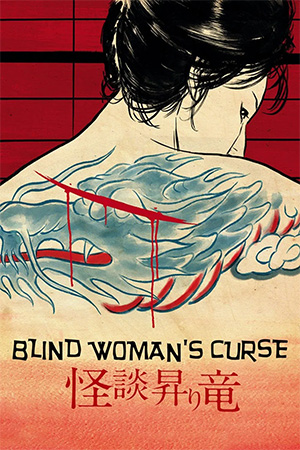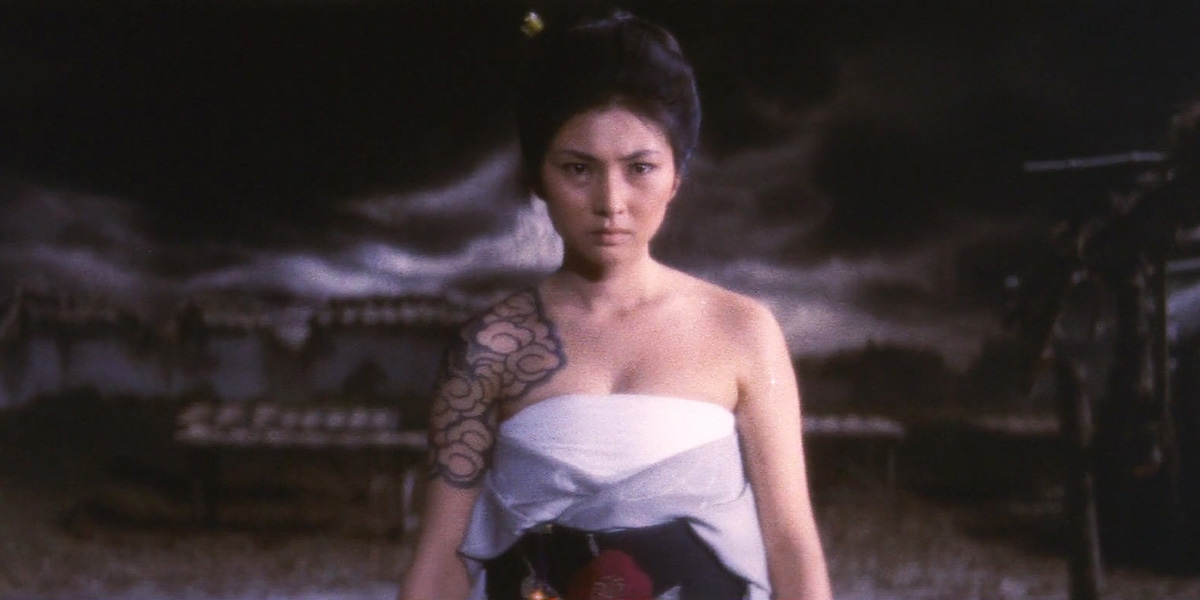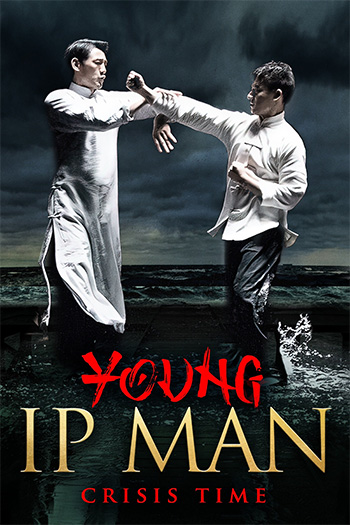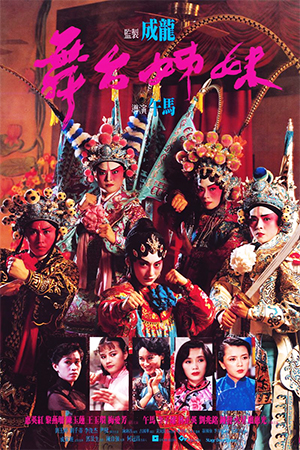A heated dispute over territories threatens to escalate rivalries between two yakuza families, the Tachibana Clan and the Dobashi-gumi, into an all-out war. Inheriting the leadership after her father’s passing Akemi Tachibana (Meiko Kaji) has freshly returned from three years jail to confront encroaching opponent Dobashi (Toru Abe) and his ranks. Rogue interloper Aozora (Ryohei Uchida) stirs up additional trouble, whilst former gangster Tani Shouichi (Makoto Sato) steps in to lend his support to Akemi, whom he has come to admire for her beauty and strength.
With tensions gradually rising between the sworn enemies, and Dobashi framing the Aozora Clan for the double murder of Tachibana men, a new player enters the game. Blind swordswoman Aiko Gouda (Hoki Tokuda) appears from the shadows to offer her services to Dobashi. Shortly thereafter, female recruits of the Tachibana Clan start turning up dead, their gang tattoos flayed from their backs and blunt threats of further murders left with the bodies. Recalling her past, Akemi becomes unshakeably convinced that she has fallen under the spell of a demon cat.
Although often labelled as a horror film (with some scribes going so far as to term it “Pinky Horror”, in reference to the imaginary genre that was created for the American home video market), Teruo Ishii’s ‘Blind Woman’s Curse’ (1970) is in reality a fairly straight yakuza film; albeit one with a rather eccentric pedigree, as would be expected from the man who helmed ‘Horrors of Malformed Men’ (1969) prior. Notable also for being Meiko Kaji’s (‘Female Prisoner 701: Scorpion’, 1972) debut leading role in a feature, Ishii’s garish gangster opus inevitably has much going for it outside of the prerequisite (oft clichéd) underworld squabbling and politics. Additionally, despite having wrapped production prior, ‘Curse’ landed in cinemas after the explosive debut of the ‘Alley Cat Rock’ series (which had made Kaji a virtual overnight sensation) which surely boosted ticket sales immeasurably.
A fortuitous release date and enigmatic new leading lady aside, ‘Blind Woman’s Curse’ also benefits from a diverse and varied cast along with Ishii and Chusei Sone’s (‘Hellish Love’, 1972) potpourri of script transgressions. Veteran Toru Abe (‘Tokyo Story’, 1953) makes for an authoritative opponent to Kaji’s Akemi, Shiro Otsuji (‘Samurai’, 1965) devilishly slimy as the traitor in the Tachibana’s midst and Hoki Tokuda (Henry Miller’s spouse of the time) perfectly glacial as the enigmatic Aoki, Ishii’s eponymous blind swordswoman. Not forgetting Butoh dancer, Tatsumi Hijikata (‘Horrors of Malformed Men’, 1969), who pops up as obsessive hunchback, Ushimatsu. Hijikata’s role almost whispers of afterthought, once the character has served its purpose, yet his presence is ultimately an intrinsic element that gives rise to Ishii’s penchant for gruesome or sadistic visual flourishes.
Still freshly scorched into the public consciousness from his efforts in the lurid ‘Shogun’s Joy of Torture’ (1968) and aforementioned Edogawa Rampo (nee: Tarō Hirai) pastiche, ‘Horrors of Malformed Men’ (1969), Ishii infuses ‘Blind Woman’s otherwise generic tableau with his usual ostentatious flashes of colour and outrage. Japan’s “King of Cult Movies” spices up his chanbara-yakuza hybrid with oft-monstrous imagery of flayed corpses, stripped and tattooed flesh hung out like obscene art, psychedelic drug dens populated by squirming, naked opium addicts and, in arguably the film’s most disturbing moment, a severed head used as a grisly disguise. As with much of Ishii’s canon, once he had freed himself from television and transitioned to the big screen, even within the well-worn confines of commercial outings he managed to bring his oft-confronting aesthetic to proceedings.
Further elevated by an offbeat sense of humour, with periodic bursts of slapstick and broad comedy, Teruo Ishii’s ‘Blind Woman’s Curse’ is nothing if not memorable. In fact, as a collective, it’s fair to say that Ishii had approached his subject matter with tongue firmly in cheek (as there is laughter to be had amidst the circus of the grotesque). Yet, even when presented with the “sideshow of terror” and its faux-cannibalism or phantom-like performers, it’s blatantly apparent that we’re not engaging a “horror” film per se. The demon feline curse proves simple paranoia, the parade of horrors and bizarre imagery all perfectly explicable within the plotline. Thereby as long as one approaches ‘Blind Woman’s Curse’ as the gangster film it is, and not the genre piece it is commonly (mis)sold as, then an entertaining diversion is most certainly assured.
Review © 2014 M.C. Thomason
- Blind Woman’s Curse - June 20, 2025
- My Name Is Nobody - March 12, 2021
- Girl$ - December 4, 2020






